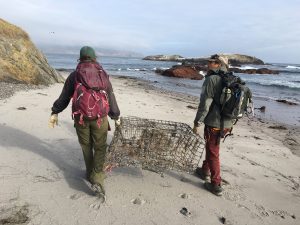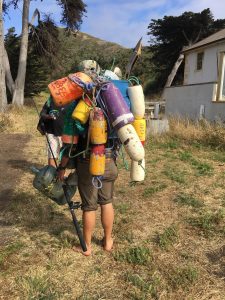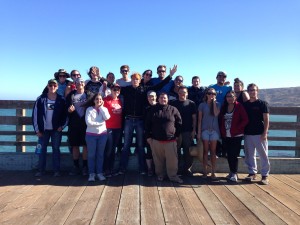Ocean Litter Removal on Santa Cruz and Santa Rosa Islands
An interdisciplinary group of CI faculty, staff and students are participating in a NOAA marine-debris program funded project to monitor the ecological effects of fishing debris removal at 7 sites in Channel Islands National Park and 2 mainland sites.
We have been awarded two NOAA Marine Debris Program grants to support our research projects in the Channel Islands. Between the two projects we have removed approximately 5000kg (11,000 pounds) of trash and debris from 7 sites on Santa Cruz and Santa Rosa Island.
The first project “Cultivating Santa Barbara Channel Stewards” (2016-2019) focused on removing and cataloging marine debris from seven sites on Santa Rosa/Santa Cruz islands and two on the mainland. SRIRS staff, CSUCI faculty in ESRM, Art and Biology, students, and volunteers removed over 6000 pounds of marine debris and counted and cataloged over 25,000 individual items of litter. We also examined the distribution of microplastic debris in beach sediments at these sites. We brought awareness to the issue of marine debris on the California Channel Islands through a variety of public and scientific conference presentations, K-12 education, and the creation and display of marine debris art (37 outreach events in total). A major component of the project was outreach to local schools spearheaded by our SRIRS founding director Dr. Cause Hanna.
Impact:
900 K-12 students reached (We have worked with students from Fremont Junior High, Frank Junior High, Rio Mesa High School, Pacifica High School, and Nordoff High School.)
565 Volunteers (Island and mainland beach clean-ups, data processing and collection).
Partners: Island Packers, National Park Service, The Nature Conservancy, Channel Islands National Marine Sanctuary, local lobster fishers.
PIs: Dr. Cause Hanna (SRIRS), Dr. Clare Steele (ESRM), Dr. Geoff Dilley (Biology) and Stephen Whittaker (NPS)
Federal funds: $ 99,928. Matching funds: $100,260. Total project: $ 200,188
The second project “Marine Debris Removal on the California Channel Islands: Improving Critical Habitats” (2020-2022), focuses primarily on removal of large debris from the remote Santa Rosa and Santa Cruz island sites. Lost and discarded fishing gear is particularly problematic on the beaches of Northeastern Santa Rosa island. These beaches are critical habitat for elephant seals, other pinnipeds and shorebirds. We are characterizing plastic debris to create a chemical profile of debris type using FTIR-ATR spectroscopy*, using ESRM’s instrument recently acquired through funding from the Department of Defense. Program manager, Joe Forrest, has developed a GIS dashboard to assist us and partners with tracking of lost and discarded fishing gear.
Impact:
This project aims to involve students who are Veterans of the US Armed Forces in research and currently employs two veterans: an ESRM graduate as Program Manager and an ESRM undergraduate as Student Assistant. Volunteer involvement has not been possible to date due to the pandemic.
Partners: Island Packers, National Park Service, The Nature Conservancy, Channel Islands National Marine Sanctuary, local lobster fishers.
PIs: Russ Bradley (SRIRS) and Dr. Clare Steele (ESRM)
Federal funds: $122,499. Matching funds: $133,487. Total project: $225,986.
Santa Rosa Island Undergraduate Research Station
CSUCI’s undergraduate research station on Santa Rosa Island provides a base for incredible learning and research opportunities. Several CSUCI students are conducting independent research projects here and I recently brought my Conservation Biology class to the island for a weekend trip to conduct sandy beach infaunal research and to use the island ecosystems to extend our knowledge of topics relating to the class including ecological restoration, biodiversity, and landscape ecology.
Spring Break 2014
During spring break 2014, my colleague Dr. O’Hirok and I visited Santa Rosa Island with seven undergraduate students. We established sandy beach monitoring sites (pictured right), conducted intertidal surveys, investigated several stream channels as future research sites and explored capstone research possibilities with the students. A number of CSUCI capstone students are currently conducting independent research projects on Santa Rosa.
Fall Semester 2014
My Conservation Biology class visited the island for an weekend in October to observe the unique properties of islands and their native species. The island provides unparalled illustrations of many of the topics that students learn about throughout the semester, and their understanding of the material is greatly enhanced by seeing these principles ‘in action’. Discussions and field exercises align with many of our existing class modules, including the following: Biodiversity; Landscape Ecology; Island Biogeography; Invasive Species; Protected Areas and MPAs; Monitoring and Mitigation; Species and Ecosystem Management.



